
The Microhylidae, commonly known as narrow-mouthed frogs, are a geographically widespread family of frogs. The 683 species are in 63 genera and 11 subfamilies, which is the largest number of genera of any frog family.

Litoria is a genus of Pelodryadidae tree frogs native to Australia, the Bismarck Archipelago, the Solomon Islands, New Guinea, the Lesser Sunda Islands, and the Moluccan Islands. It is the only genus in the monotypic subfamily Litoriinae and are sometimes collectively referred to as Australasian treefrogs. They are distinguishable from other tree frogs by the presence of horizontal irises, no pigmentation of the eyelids, and their distribution east and south from Wallacea. Over 90 species are described, but several new species are described every year on average, such as the Pinocchio frog, discovered in 2008 and described in 2019.

Tepuihyla, commonly known as Amazon tree frogs or Tepui tree frogs, is a genus of frogs in the family Hylidae found in mountains of eastern and south-eastern Venezuela and Guyana, and likely in adjacent Brazil. A tepui is a table-top mountain characteristic of the Guiana Highlands.

Triprion is a genus of frogs in the family Hylidae found in the Pacific lowlands of Mexico, the Yucatán Peninsula, and Guatemala. These frogs hide in tree-holes and plug the entrance with their strange-looking, bony heads.

Pseudacris is a genus of frogs in the family Hylidae found in North America ranging from the Pacific coastline to the Atlantic.
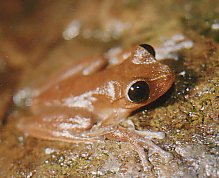
Nyctimystes is a genus of tree frogs in the family Pelodryadidae. They are principally Papuan species, but also inhabit islands in the Moluccas. All species in this genus have one distinct feature that separates them from other species in the family, the lower eyelid is marked with pattern of lines, veins, or dots. This feature presumably acts as camouflage when the frogs are at rest during the day.
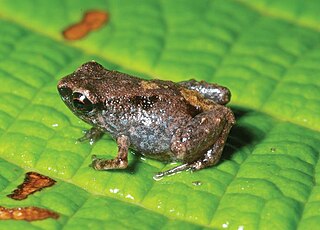
Asterophryinae is a subfamily of microhylid frogs distributed in an area from the Peninsular Malaysia through the Malay Archipelago to northern Australia.
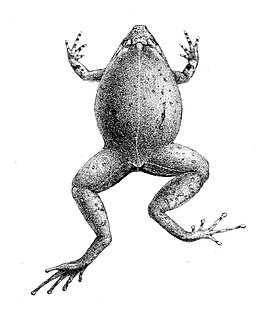
Xenorhina is a genus of microhylid frogs. The genus is endemic to New Guinea. They are sometimes known as the snouted frogs or fanged frogs, the latter referring to the now-synonymized genus Xenobatrachus.

Austrochaperina is a genus of microhylid frogs found on New Guinea, New Britain and Australia.

Choerophryne is a genus of microhylid frogs, commonly known as Torricelli mountain frogs, endemic to New Guinea. These frogs are small, with the body length measured from snout to vent between 11–23 mm.
Copiula is a genus of microhylid frogs endemic to New Guinea. The common name Mehely frogs has been coined for them. They are leaf-litter inhabitants.

Platymantis is a genus of frogs in the family Ceratobatrachidae. They are commonly known as wrinkled ground frogs, ground frogs, and forest frogs.
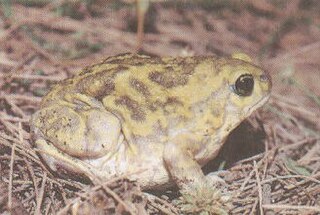
Uperodon is a genus of microhylid frogs. They occur in South Asia and Myanmar. Uperodon reached its current composition in 2016 when the genus Ramanella was brought into its synonymy. The common names of these frogs are globular frogs and balloon frogs in reference to their stout appearance, or dot frogs, the last specifically referring to the former Ramanella.
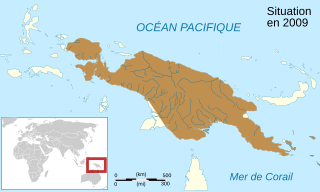
Hylophorbus rufescens is a species of frog in the family Microhylidae. It is endemic to New Guinea and some nearby islands, and occurs in both West Papua (Indonesia) and Papua New Guinea. Common name red Mawatta frog has been coined for it.
Djoko Tjahjono Iskandar is an Indonesian herpetologist who studies the amphibians of Southeast Asia and Australasia. He is a professor of biosystematics and ecology at Bandung Institute of Technology in West Java, Indonesia.
Hylophorbus rainerguentheri is a frog species in the family Microhylidae. It is endemic to New Guinea and only known from the Huon Peninsula in the Morobe Province, Papua New Guinea. The specific name rainerguentheri honours Rainer Günther, a German herpetologist from the Natural History Museum, Berlin. Common name Huon Mawatta frog has been proposed for this species.
Cornufer is a genus of frogs in the family Ceratobatrachidae. It has been greatly expanded by Brown, et al. (2015) to include most Australasian frogs in the family Ceratobatrachidae. Species are found in Melanesia and Polynesia — in Palau, Fiji, New Guinea, and in the Admiralty, Bismarck, and Solomon Islands.

Hylophorbus proekes is a species of frog in the family Microhylidae. It is endemic to Papua New Guinea and only known from the vicinity of its type locality on the southern slope of Mount Sapau in the Torricelli Mountains, West Sepik Province.
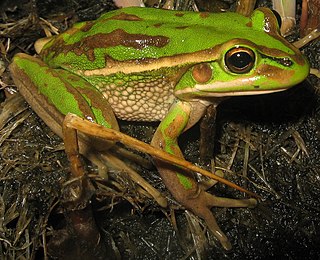
Ranoidea is a genus of frogs in the subfamily Pelodryadinae. They are found in Australia, New Guinea, and two nearby groups of islands: the Maluku Islands, and the Louisiade Archipelago. The circumscription of this taxon is still controversial.














